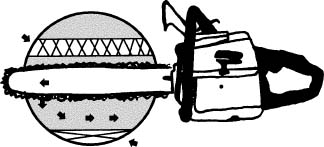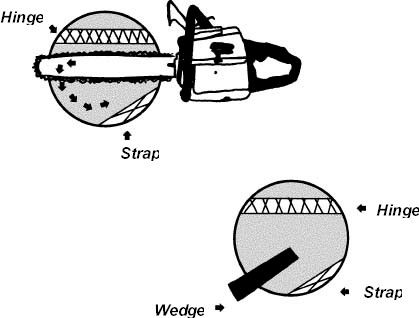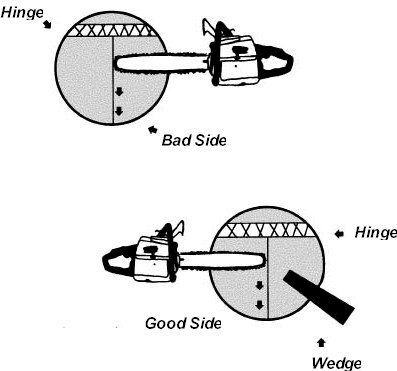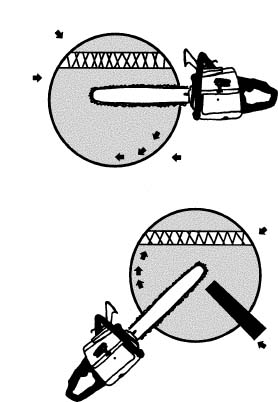Tim's Tips | ||||||||
| ||||||||
Swing in on starting corner, run saw through tree. | ||||||||
3. Trees with Forward Lean - Trees with forward lean can easily split, pull splinters, or barber chair. Therefore, it is important on these trees to use the bore cut, form the desired hinge thickness and then complete the back cut leaving a strap of uncut wood at the back of the tree. This strap of wood and the hinge will hold the tree in place and prevent it from falling until you are ready to release it. | ||||||||||||||||||
| Trees with Forward Lean | ||||||||||||||||||
 | ||||||||||||||||||
| Hinge | ||||||||||||||||||
| Strap | ||||||||||||||||||
Standing along the escape route, the logger may now cut the last of the strap about 1/2 to 1 inch below the level of the back cut. The strapping wood will split, releasing the tree and allow it to fall in the desired direction while the logger is retreating on the escape route out of danger. Sometimes if a tree has very little forward lean, the logger may elect to just cut straight back out of the tree without leaving a strap. If the tree diameter is too big for the chain saw bar to reach all the way through, the tree can be bore cut from both sides. Using the corner of the notch to guide the start of each bore cut will ensure the cuts are fairly level. It is important to bore cut from the bad side first reaching no more than half way through the tree. The logger may then cut back out of the tree on the bad side, move himself to the good side of the tree and bore cut through to meet the first cut. He then cuts back out on the good side leaving a strap which can be released from the escape route. With experience, the bore cuts will meet exactly, or almost exactly, forming a level precise stump. | ||||||||||||||||||
| Cut #2 | Good Side | Cut #1 | ||||||||||||||||

| Bad Side | |||||||||||||||||
| Cut #3/Final Cut | ||||||||||||||||||
4. Trees with Back Lean - Trees with back lean present special problems in that they may set back on the saw while making the back cut. We recommend the use of a wedge on all trees with back lean. If the tree is small enough for the bar to reach all the way through, the simplest method is to bore cut the tree from the good side forming a precise hinge, swing the tip of the bar towards the rear of the tree leaving a strap of wood to prevent the tree from sitting back. Insert a wedge between the hinge wood and the strap. Cut the strap and drive the wedge with an ax. This is illustrated below. | |||||||||
| Wedge Cut | |||||||||

| |||||||||
If the tree is too big for the bar to reach all the way through, bore from the bad side first, remembering not to bore more than half way through the tree. Bring the saw straight to the back of the tree on the bad side. Insert a wedge in this opening. The next step is to bore from the good side slightly below the first bore cut and cut back through the tree about 1/2 inch below the wedge. Hitting the wedge a couple of times with an ax will split the holding wood and force the tree over. Refer to the illustrations above. Care must be taken to never saw the supporting wood under the wedge. | |||||||||

| ||||||||||||||||||
| Make the second cut 1/2" below first cut to avoid hitting the wedge. | ||||||||||||||||||
Another method to use on trees that are bigger than the bar is to first bore half-way through the tree on the bad side, start cutting out towards the back of the tree and then swing the saw around the tree towards the good side. When the saw is approximately half way around, insert a wedge behind it and continue cutting toward the good side until the hinge is completely formed. Take the saw out and drive the wedge until the tree begins to fall. Please refer to the illustrations below. | ||||||||||||||||||
| Hinge | Cutting Around the Back | |||||||||||||||||
 Bad Side 資料來源: | ||||||||||||||||||
| Good Side | ||||||||||||||||||
| Hinge | ||||||||||||||||||
沒有留言:
張貼留言